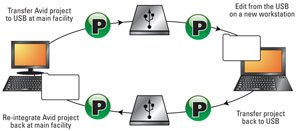Marquis’ Project Parking
One of the original promised benefits of file-based workflows was less footage. Digital cameras could be turned on and off more quickly. Some could even record constantly to a loop before you hit record, so there would be no need to “leave the tape running.”
However, in reality, less footage has not turned out to be the case. It is not uncommon for crews to come back with 500GB of media after less than a week of shooting, and, these days, you can carry 10 hours of media in your back pocket. So, the challenge has become the issue of an always full edit storage, and many post-production editors wonder what they can do about it.
Marquis Broadcast’s Project Parking gives editors the tools to find out what is using up space on their Avid edit storage through a complete storage and project analysis. Once that step is accomplished, users can then delete clutter before archiving storage-intensive projects and all of their media elsewhere.
Projects and media can be analyzed by size, project, location, age, duplicated or orphaned files. Snapshots of versions of projects can also be taken at the touch of a button. The solution then allows projects to be moved between tiers of storage or to different locations and incremental project archive versions to be created, while still maintaining a usable and easily accessible format for future retrieval and use.
Storage and recall
Edit storage can become full for many reasons: stalled projects, finished projects, left over render files, duplicate files and media files no longer used by any online project. Project Parking helps manage that storage more efficiently.
The solution works by analyzing all projects and media across all workspaces. It then allows that analysis to be viewed in the UI, and users can rank projects in the most appropriate way. This may be in order of total file size, number of files associated with a project, which workspaces the media is on, or whether media is offline. The location of any duplicate files can also be identified, as can any orphaned media not associated with a project.
The professional video industry's #1 source for news, trends and product and tech information. Sign up below.
Stalled projects can then be taken offline to free up space. It is possible to archive whole projects (all bins, sequences and media files) and update with new versions or archive only important bins. Archived, projects can be moved through the cloud and around the world. A project is transferred with its entire media to any storage so that it can be restored to a new facility, workstation or laptop and edited immediately. (See Figure 1.) Also, orphan and duplicate media files can be managed by moving them offline, which frees up the edit storage.

Figure 1. Project Parking transfers allow users to move Avid projects to new workstations or locations.
Project Transfer functionality can be used to ensure that all media for a project is in a particular media workspace. For example, media often gets placed in the wrong location, which makes it difficult to find or move later on. Project Parking allows media that has ended up in several different places to be collected and put back in one location, so it can be edited by another workstation in the future. Alternatively, the Transfer functionality allows a project’s media to be moved to a laptop’s local disk for editing off-site, or to a new removable disk for transportation to a new facility.
Retrieval (bringing a project back from deep storage or just from a weekend’s editing at home) is easily achieved by restoring whole projects or just the required bins of an archived project, for re-editing to any other project by listing all archived Avid projects in each destination. Each archive provides information on when it was made. It also details the number of versions that are available along with user comments. The user can choose which version and where to restore the Avid project to, selecting how the original workspaces maps onto currently available ones. It is also possible to merge a new version of a project with one currently online.
Summary
Project Parking gives users the tools to improve the efficient use of high-value edit storage and to reduce capital expenditure on additional edit storage by copying Avid projects to nearline, offline efficient IT storage or removable storage. The solution improves the reliability and speed of archiving by allowing the movement of complete Avid projects easily from one site to another, or from facility to home, so users can have full confidence that projects will be in exactly the same state as when they were archived.
This enables editors to efficiently manage projects, take complete Avid projects off-site and even re-edit away from the central facility and then merge back again. In addition to those workflow benefits, work can also be protected by creating snapshots of projects before major edit changes, interruptions to production, or for simply handing over to other editors.
—Ben Miles is business development manager, Marquis Broadcast.
